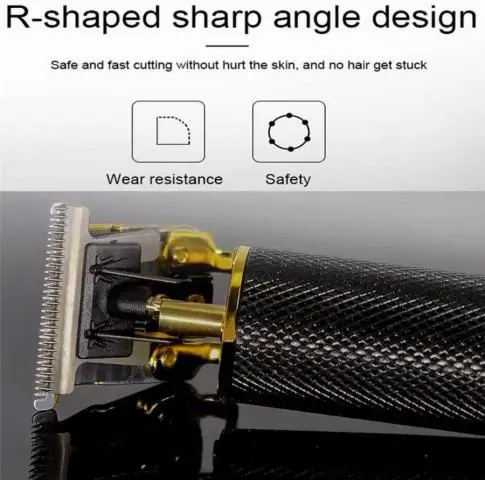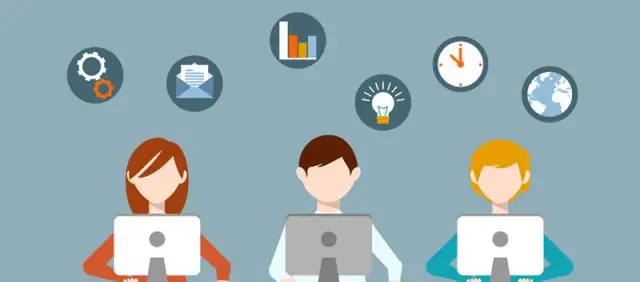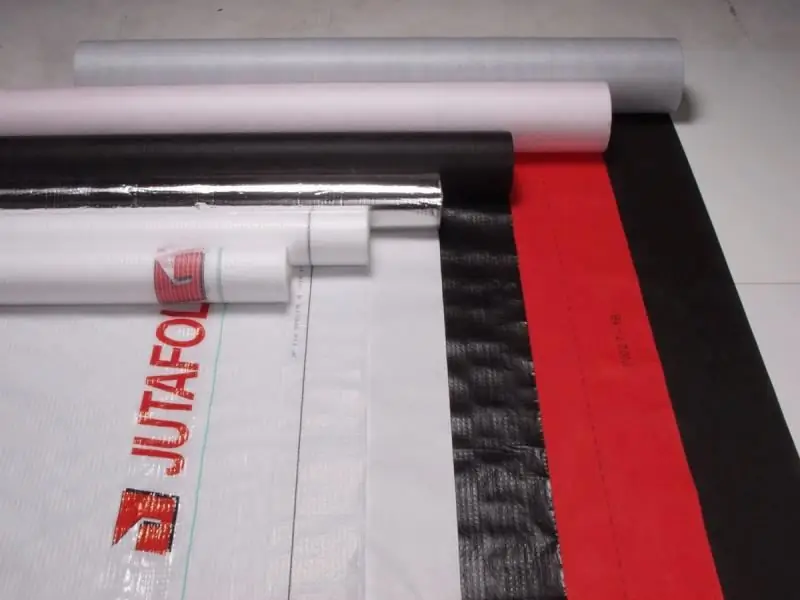
Table of contents:
- Author Bailey Albertson [email protected].
- Public 2023-12-17 12:53.
- Last modified 2025-06-01 07:32.
Waterproofing film for the roof: material features and laying technology

Proper arrangement and insulation of the roof involves protecting the rafter system from moisture. To do this, use a waterproofing film, which should be selected correctly, correctly calculated its amount and carefully laid on the roof.
Content
-
1 What is a waterproofing film
- 1.1 Properties and characteristics of the waterproofing film
- 1.2 Types of waterproofing films and their features
- 1.3 Brands and manufacturers of waterproofing films
-
2 Installation of waterproofing on the roof
- 2.1 Preparation for laying the waterproofing film
- 2.2 Technology of laying waterproof film on the roof
- 2.3 Video: features of installing a waterproofing film on the roof
What is a waterproofing film
The insulated roof allows you to organize a functional attic space and significantly reduce heat loss. To do this, create a roofing "pie", which includes several layers of materials - each of them performs a specific function. Waterproofing is one of the important ingredients in the pie. This material is a durable modern film that prevents moisture from entering the house. Thus, the rafter system, insulation, load-bearing walls are protected from rain and other precipitation.

Waterproofing is an important component of the roofing pie
Properties and characteristics of waterproofing film
Waterproofing materials are produced in rolls. The parameters of one roll differ depending on the manufacturer, but the average weight of one element is 9 kg, the length of the web is 50 m, and the width is 1.5 m. Other options are presented on the market, and the choice is made depending on the characteristics and properties of the web …

The material produced in rolls is easy to mount
Waterproofing materials from modern manufacturers have such properties as:
- pronounced high water resistance;
- UV resistance;
- anti-condensation qualities;
- elasticity and mechanical strength of the structure;
- lack of reaction when interacting with insulation, roofing, etc.
High-quality waterproofing material is characterized by the fact that it can be operated at temperatures ranging from -40 ° C to +80 ° C. The canvases are lightweight and therefore do not load the roof truss system. The strength and service life of the material depends on the structure. Multilayer films equipped with a reinforcing mesh are stronger and more durable, they can serve from 20 years. Simple and thin membranes or films require more frequent replacement, they are torn under mechanical stress.
Types of waterproofing films and their features
Modern waterproofing structures can serve not only to protect against moisture from outside. For arranging the roof, multifunctional materials are in demand that protect against internal fumes and condensation. Depending on these properties, films are divided into several types. For example, anti-condensation models are popular, which absorb water vapor and gradually remove it outside. Diffusion or superdiffusion membranes have a more modern structure that allows air to circulate in the under-roof space. When installing such canvases, an air gap is required between the film and the insulation for the effectiveness of the material.

Reinforced waterproofing film is strong and durable
The main options for roof protection are the following waterproofing materials:
-
polyethylene film is a simple option that comes in several forms. The material can be regular HDPE or microporous polyethylene that allows air to circulate under the roof. The reinforced reinforced film is equipped with a fiberglass mesh and consists of three layers. The service life of the latter type is more than 35 years;

Waterproofing reinforced film Reinforced films consist of three layers, and the mesh makes the material durable
-
films of the polypropylene type: they are more resistant to ultraviolet radiation and more durable than polyethylene films. Polypropylene fabrics have a viscose-cellulose layer that absorbs condensate and promotes its evaporation. This layer is mounted towards the insulation with a distance between the structures of at least 5 mm;

Polypropylene waterproofing film Polypropylene fabrics are UV resistant
-
glassine is a roofing board impregnated with refractory bitumen and plasticizers. The material is supplied in rolls. It is laid on the inside of the roof as a vapor barrier. It can be used to equip water protection before installing the external roofing;

Glassine for the roof Glassine is suitable for both flat and pitched roofs
-
perforated, or diffusion, membranes: they differ from previous types in that they have a high cost due to the special structure of the material. The nonwoven fabric is made of synthetic fibers, has a microporous structure, which ensures the accumulation and timely removal of moisture. This type of waterproofing can be diffusion (medium vapor permeability), superdiffusion (high vapor permeability) and pseudodiffusion (low vapor permeability).

Membrane roof waterproofing Membrane cloths promote moisture evaporation
Waterproofing film brands and manufacturers
There are various brands of films from many manufacturers on the roofing materials market. At the same time, there are especially popular options, the popularity of which is due to a good combination of cost and high technical characteristics. Similar materials are produced by the following manufacturers:
- Ondulin presents a wide range of roofing materials, including external roofing, steam and waterproofing sheets and additional structures;
- Folder produces high-quality anti-condensation films, as well as other types of membranes to protect the roof from moisture;
- Yutafol is a well-known manufacturer of modern type waterproof and vapor barrier sheets with a service life of several decades;
- Tyvek offers a wide range of both simple and multilayer films that provide excellent moisture and condensation protection.
The assortment of these manufacturers includes several particularly popular material options. Noteworthy is the film "Ondutis RS", which is resistant to ultraviolet radiation and has a mass of 90 ± 10% g / m². The vapor permeability of this structure is 10 g / m² in 24 hours.

The Ondulin company also produces universal waterproofing films
Folder Anticondensat is characterized by zero vapor permeability, which is UV-stable without additional coating for three months.

Folder film is lightweight and has zero vapor permeability
Tyvek Soft water protection is a single-layer polyethylene material with a high level of strength. The web weight is 60 ± 10% g / m², and the operating temperature ranges from -73 ° C to +100 ° C. Without roofing, the material is UV resistant for four months.

Tyvek Soft waterproofing film is characterized by increased UV stability
Installation of waterproofing on the roof
The basis for laying the waterproofing film is the roof rafter system, that is, the work is carried out at a height. Therefore, it is imperative to comply with safety measures, the use of a safety cable, a strong ladder and a thoughtful lifting of building materials to the roof. It is also worth preparing the necessary tools, the main of which are a stapler and staples, a sharp knife, and a tape measure. After creating a rafter system, the distance between the elements of which should be about 1.2 m, waterproofing protection can be laid. To ensure greater strength, the rafters can be treated with a wood preservative.

The film is attached to clean and dry rafters
Preparation for laying a waterproofing film
Preparation for fastening a waterproofing film does not require special actions, but it involves the mandatory development of the rules for fixing the material. The main features of this process and the general arrangement of the roof are expressed in the following:
- the waterproofing film is mounted on top of the insulation laid between the rafters. At the same time, a counter-lattice of slats with a section of 30x50 mm is attached to the rafters, and then the material is laid. This is necessary to provide a ventilation gap;
- the film should not be pulled too tightly - this can damage the web. When fixing the anti-condensation sheet, a slight sagging of the material by about 10-20 mm is allowed in the space between the rafters;
- the canvases are fixed with an overlap of at least 15 cm. To connect the joints, use adhesive tape intended for outdoor use;
- when arranging the roof, the ridge area can be completely covered with a superdiffuse membrane, which has a vapor permeability of at least 1000-1200 g / m² per day. In other cases, a gap of about 200 mm should be made between the sheets of the film for normal air circulation.
Roof waterproofing film laying technology
For the installation work, prepare a sealant for external insulation. You also need self-tapping screws with an anti-corrosion coating, a low-speed drill and a hacksaw for wood. After preparation, the work technology involves the following main stages:
-
On top of the rafter elements, slats with a cross section of 30x50 mm are attached, which are necessary to ensure a ventilation gap. Next, a roll of waterproofing material is unfolded, the canvas is spread horizontally and a part is cut off with a margin of about 30 cm.

Cutting and laying the canvas The material for waterproofing begins to be laid from the eaves
-
The first canvas is fixed with staples and a stapler, starting from the edge. Then the second strip is laid with an overlap of 15 cm on the first and also reinforced with staples. Thus, the sheets are installed up to the ridge itself. Superdiffuse membranes can be laid in a continuous layer on the ridge, while other versions are fixed at intervals of 200 mm.

Ridge foil The film is mounted on the ridge taking into account the type of material: for example, superdiffuse membranes can be laid in a continuous layer
-
The joints of the canvases are fixed with adhesive tape for outdoor use. After that, a counter-lattice is mounted from 50x30 mm slats. You can pre-treat the slats with an antiseptic, wait for the composition to dry and continue working. Roofing material is laid on top of these elements, for example, corrugated board. All work is carried out at an air temperature of at least -5 ° C.

Layout of the film on the roof The lathing for the roofing is mounted on top of the waterproofing
-
In the area of the valley, it is necessary to lay the waterproofing in the form of a solid sheet on a continuous crate. In the cornice zone, the canvas is passed under the drainage gutter, which has a continuous attachment to the cornice board.

Layout of the material under the drip The canvas is fixed close to the eaves board
Video: features of installing a waterproofing film on the roof
Waterproofing will provide the roof of the house not only with durability, but will also create a comfortable environment inside the building. Therefore, when arranging the roof, an error-free choice of material and correct installation of the film are required.
Recommended:
Trimmer For Nose, Ears And Eyebrows: Which One Is Better To Choose, How To Use + Video

Trimmer for nose, ears and eyebrows, its purpose, device and principle of operation. The main criteria for choosing the ideal device, features of care and repair
Choosing A Boiler: Which Company Is A Storage Water Heater Better, Including An Electric One, How To Choose, Characteristics And Other Aspects

Types of water heaters. Features of the device and technical characteristics of boilers. How to choose a boiler for heating water
Coffee Turka: How To Choose The Right One, Which Is Better, Copper Or Brass, Electric Or For A Stove And Other Options + Reviews, Photos, Videos

Coffee in the morning is an undeniable classic. And to make it great, you need to choose the right Turk. Our article will help you decide
Dishwasher Salt: Why Is It Needed, Which One To Choose And How To Use It, Is It Possible To Replace The Usual One, A Review Of Popular Brands, Reviews

Dishwasher salt: pros and cons. Differences between common salt and salt for PMM. Means of various brands. How to use salt. Reviews
Roof Waterproofing Membrane - Which One Is Better To Choose And How To Install It Correctly

Features of different types of waterproofing films. How to choose the best option and mount it correctly. Overview of waterproofing membrane manufacturers
